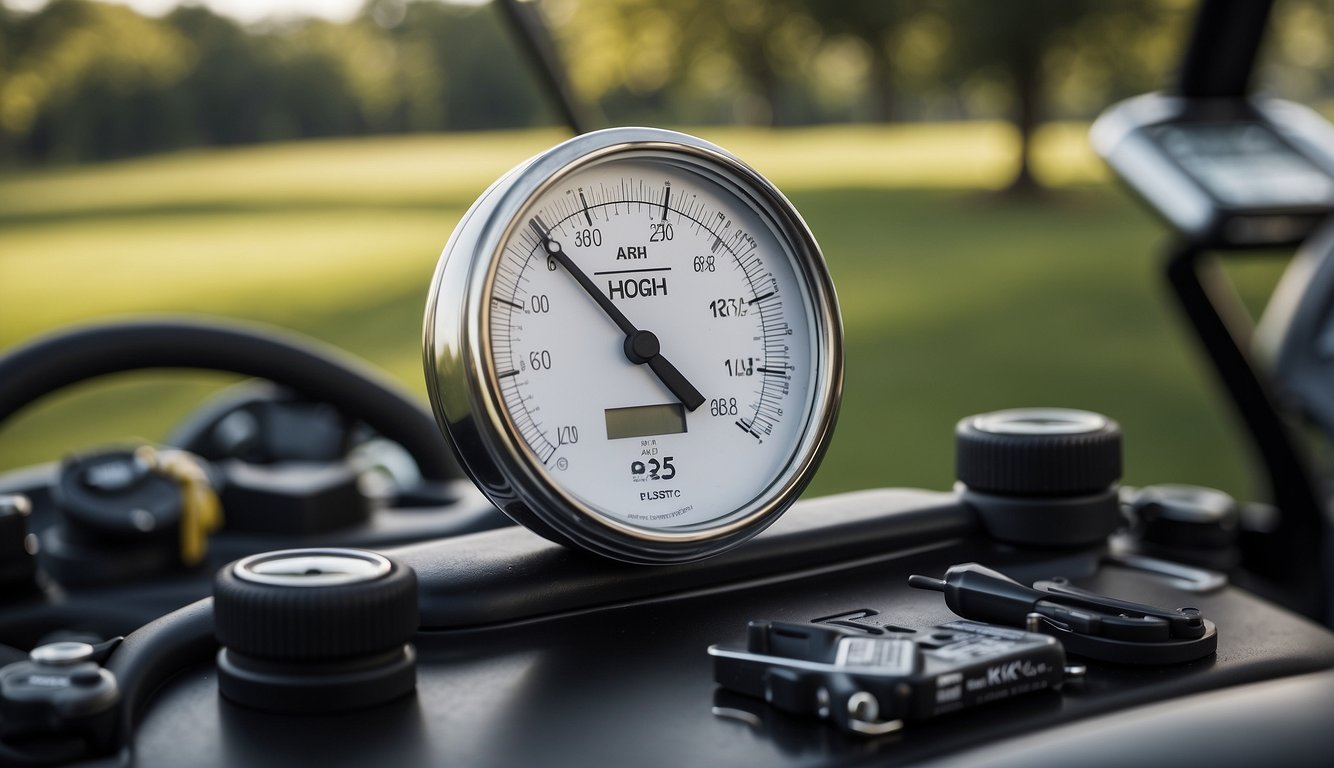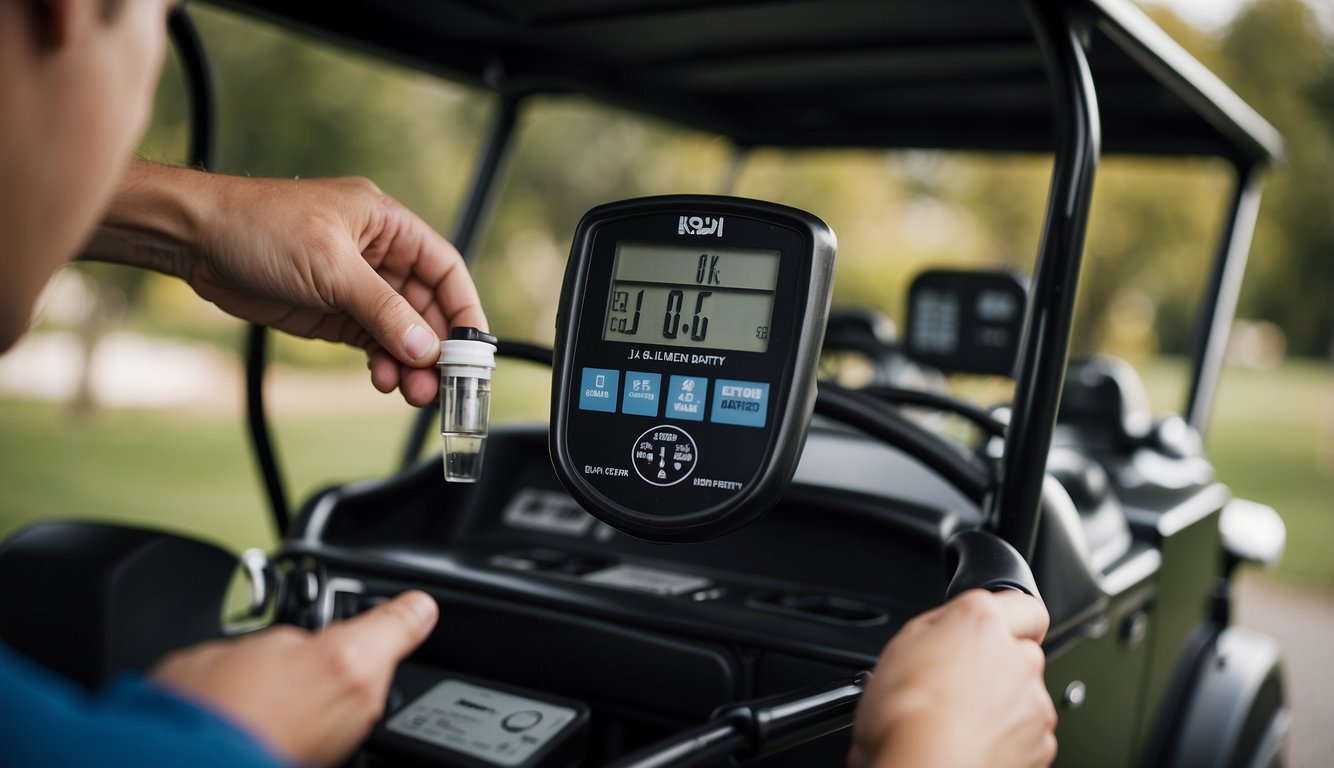Maintaining the health of golf cart batteries is crucial for the optimal performance and longevity of your vehicle. To ensure that your golf cart is always ready for the course, it’s important to regularly check the condition of its batteries. One of the most effective tools for assessing a battery’s health is a hydrometer, which measures the specific gravity of the electrolyte solution within each cell. This reading can give you a clear picture of each battery’s state of charge and overall health.

Using a hydrometer is straightforward and provides valuable data that can help prevent battery failures before they occur. The specific gravity test helps identify if any cells are weaker than others and if the battery needs water or charging. By incorporating regular hydrometer checks into your maintenance routine, you can extend the life of your golf cart batteries and avoid the inconvenience and cost of unexpected downtimes. Knowing how to perform a hydrometer test accurately and safely can save you time and money, and keep your golf cart running smoothly.
Key Takeaways
- A hydrometer is a vital tool for assessing golf cart battery health.
- Specific gravity tests with a hydrometer can identify maintenance needs.
- Regular battery checks can extend the life of your golf cart batteries.
Understanding Golf Cart Batteries and Hydrometers
In maintaining the health of our golf cart batteries, understanding the role of a hydrometer and the basics of the batteries themselves is essential. We’ll explore the specific applications of a hydrometer in this context and discuss the fundamental attributes of golf cart batteries.
Functions of a Hydrometer
A hydrometer is an instrument we use to measure the specific gravity or density of the electrolyte solution within lead-acid golf cart batteries. Specific gravity is a critical metric since it correlates directly to the state of charge in the battery. Here’s how we typically use a hydrometer:
- Safety First: Before using a hydrometer, ensure you wear protective gear like gloves and goggles.
- Reading Specific Gravity: Insert the hydrometer into the battery cell, and draw the electrolyte solution into its tube. The float inside the tube will rise to a level that corresponds with the battery’s specific gravity.
- Interpreting Results: Specific gravity readings generally range from 1.100 (discharged) to 1.300 (fully charged). Consistent readings across all cells indicate a healthy battery, while significant variances can signal issues.
Basics of Golf Cart Batteries
Golf cart batteries are typically lead-acid batteries, designed to deliver the sustained power required for the repeated stop-and-go nature of a golf cart’s operation. Here are some essential aspects:
- Structure: Each battery has cells with a lead-dioxide cathode, a sponge lead anode, and a sulfuric acid electrolyte.
- Voltage and Capacity: Golf cart batteries commonly come in 6V, 8V, or 12V variations, and a full fleet of batteries is connected in series to achieve the desired total voltage required by the cart.
- Maintenance: Regular checks of electrolyte levels, terminal connections, and full charges after use are vital to preserve battery life.
- Periodic Testing: Checking individual cells of our golf cart batteries with a hydrometer can reveal their charging state and health, contributing to effective maintenance routines.
Preparing for the Hydrometer Test
Before we proceed with the hydrometer test on golf cart batteries, it’s critical to prioritize safety and ensure that we have the appropriate equipment on hand. Proper preparation is the foundation for an accurate and safe assessment.
Safety Measures
When preparing to use a hydrometer on golf cart batteries, we must take several safety precautions:
- Wear Safety Gloves: It’s essential to protect our hands with safety gloves when handling batteries and the hydrometer. The gloves should be made of a non-conductive and acid-resistant material.
- Use Safety Goggles: Protecting our eyes with safety goggles is crucial. Working with batteries can pose a risk of splashing acid or other debris, so proper eye gear is necessary.
- Protective Gear: Besides gloves and goggles, we should wear additional protective gear if available, such as an apron to safeguard our clothing from any accidental spills.
- Work in a Well-Ventilated Area: Ensure the testing area is well-ventilated to dissipate any potentially harmful gases released from the batteries during testing.
Gathering Necessary Equipment
Having the right equipment is just as important as following safety protocols. Here’s what we need for the hydrometer test:
- A Quality Hydrometer: The primary tool for this test, a hydrometer, must be clean and in good working order.
- Distilled Water: To fill the battery cells (if needed), we use distilled water to avoid introducing contaminants.
- Clean Cloth: A clean cloth will be useful for wiping away any surface debris from the battery terminals before testing.
- Notepad and Pen: We should have a notepad and pen ready to record our readings from each battery cell for further evaluation.
- Voltmeter (Optional): Although not necessary for the hydrometer test itself, a voltmeter can be a complementary tool to measure the battery’s state of charge.
By adhering to these preparation steps, we lay the groundwork for an effective and secure hydrometer test of our golf cart batteries.
Conducting the Specific Gravity Test
In the maintenance of golf cart batteries, measuring the specific gravity of each cell provides an accurate assessment of a battery’s health and charge level. We use a hydrometer for this purpose—a tool specifically designed for this task.
Measuring Cell Specific Gravity
To measure the specific gravity of a battery cell accurately, we follow these steps:
- Safety First: Always wear eye protection and rubber gloves to prevent any acids from contacting skin or eyes.
- Remove Cell Caps: Carefully remove the caps from the cells of the 6-volt deep cycle golf cart battery.
- Draw Electrolyte Sample: Insert the hydrometer into the cell and draw in enough electrolyte solution until the hydrometer’s float is buoyant, but not touching the sides of the hydrometer’s body.
- Take the Reading: Ensure the hydrometer is stable and note the specific gravity reading where the surface of the electrolyte crosses the calibrated markings on the hydrometer.
Interpreting Hydrometer Readings
With our specific gravity readings, we can now interpret the health and charge of the battery:
- Fully Charged – A reading of 1.280 or above indicates a fully charged state.
- Partially Discharged – Readings from 1.225 to 1.275 suggest a partially charged battery.
- Discharged – If the specific gravity is around 1.145, the battery is discharged and requires charging.
- Consistency Between Cells – All cells should have consistent specific gravity readings—if not, it may indicate a fault in one or more cells.
It’s important to adjust hydrometer readings for the temperature of the electrolyte solution, as temperature can affect the specific gravity. Most hydrometers come with a temperature correction chart for accurate analysis. Use this to correct your readings for precise results.
Advancing Battery Performance Through Effective Testing
To ensure the reliability and longevity of golf cart batteries, we leverage advanced testing methods that gauge performance and identify potential issues before they lead to failure.
Utilizing Advanced Testing Methods
In our quest for optimal battery performance, we turn to a multilayered approach. Firstly, voltmeters serve as our go-to tool to check the static state of charge, giving us a quick snapshot of voltage levels; a 36-volt battery at peak charge should measure close to 39 volts, while a 48-volt should be near 51 volts. When conducting a battery load test, we deploy a battery load tester to apply a significant load to the battery. During this test, a healthy battery should maintain a steady voltage under load, indicating robust performance.
For detailed internal battery health assessment, hydrometers are indispensable. These simple devices measure the specific gravity of the battery acid, offering insight into the electrolyte’s condition, which in turn reflects the battery’s state of charge. Regular maintenance and testing with a hydrometer are critical since a fluid’s specific gravity alters with charge level, where plain water’s gravity is indexed at 1.000.
Enhancing Longevity and Reliability
Regular maintenance doesn’t just involve cleaning terminal connections; it extends to ensuring each cell within our batteries is filled with distilled water to the appropriate level before testing. Discharge testing is another component of our regimen, ensuring that batteries can hold charge as expected during typical usage.
By integrating a mix of multimeter readings and load testing, we can confirm that our batteries are not just meeting but surpassing their expected performance benchmarks. This thorough approach ensures each battery provides reliable power and achieves its maximum possible lifespan, ultimately delivering the dependability our users require for their golf carts’ operation. We utilize these tools to systematically verify that every cell within the battery is functioning as intended and to preemptively address any signs of degradation.
Maintaining Golf Cart Battery Health

Proper maintenance is essential for prolonging the life and health of our golf cart batteries. By employing the right procedures, we ensure that the battery cells function optimally and that we minimize the risk of corrosion and damage.
Regular Inspection: We frequently check the battery terminals for any signs of corrosion. If found, we clean them with a solution of baking soda and water to prevent any potential issues with power delivery or charging.
Water Levels: We must regularly measure and maintain water levels within each cell after charging the batteries, ensuring they cover the lead plates. Distilled water is preferable as it prevents mineral buildup. Water levels are critical; too low and the plates get damaged, too high and the electrolyte may overflow during charging.
Balancing Charge: Every month, performing an equalizing charge helps balance the charge across all battery cells, which is crucial for their collective health. This also involves making sure that each cell’s specific gravity is within the healthy range using a hydrometer.
Keeping Terminals Tight: To prevent movement and potential short circuits or disconnections, we always make sure the battery terminals are secure and tight.
Here’s a table indicating the state of charge as determined by specific gravity:
| Specific Gravity | State of Charge |
|---|---|
| 1.280 | Fully charged |
| 1.270 | 75% charged |
| 1.190 | 50% charged |
| 1.145 | Discharged |
By adhering to these practices, we extend the longevity and reliability of our golf cart batteries.
Troubleshooting and Addressing Common Problems

When we use a hydrometer to assess the health of golf cart batteries, we’re primarily looking for specific gravity variations that indicate charging issues or a battery nearing the end of its life cycle. Here’s how we can troubleshoot common problems:
Irregular Readings Across Cells
- Check each battery cell with the hydrometer.
- Anomalies often suggest that a failing battery cell is present.
- We perform load testing on questionable cells to confirm.
Consistently Low Specific Gravity
- Persistent low readings can signal undercharging or sulfation.
- Sulfation occurs when batteries are left discharged for prolonged periods.
- To prevent this, we ensure regular and complete charge cycles.
Discoloration of the Electrolyte
- Gray or brown tint may reveal that the battery life is shortening.
- Discoloration could also point to contamination or degradation within the cell.
Hydrometer Reading Tips
- Always use the hydrometer at the battery’s temperature for accuracy.
- After testing, we make certain to account for temperature by referring to a temperature correction chart.
Voltage and Performance Correlation
- We also measure the battery’s voltage with a voltmeter in conjunction to hydrometer tests.
- Both low voltage and specific gravity readings can signal a need to prolong battery life through proper maintenance practices or to prepare for a replacement.
In summary, we apply an accurate and methodical approach using these tools, making sure our golf cart batteries deliver optimal performance and have an extended lifespan. By systematically troubleshooting, we address issues before they lead to battery failure.
Frequently Asked Questions
In this section, we address some of the most common queries regarding the use of a hydrometer to test golf cart batteries. Understanding the specific gravity of your battery will provide insights into its health and charge levels.
How do you properly test the specific gravity of a golf cart battery using a hydrometer?
To test the specific gravity, we first ensure the battery is fully charged. We then remove the battery caps and draw electrolyte into the hydrometer. The hydrometer’s built-in float will rise to a level that allows us to read the specific gravity, which can be matched against standard reference values to assess battery condition.
What do the readings on a hydrometer indicate about golf cart battery health?
Hydrometer readings give us a specific gravity value that reflects the charge status of the battery. A high specific gravity reading typically indicates a fully charged battery, whereas a low specific gravity value suggests a discharged or failing battery. Consistently low readings across cells might indicate it’s time for a replacement.
How can you accurately measure electrolyte levels in a golf cart battery with a hydrometer?
Accurate measurement is achieved by drawing enough electrolyte into the hydrometer to completely float the device’s measuring scale. We ensure the hydrometer is level and that the electrolyte temperature is accounted for, as temperature can affect the specific gravity readings.
What is the correct procedure for checking a 36-volt golf cart battery system with a hydrometer?
To check a 36-volt system using a hydrometer, we test each cell individually. We compute the average specific gravity of all cells after testing. If the specific gravity numbers differ significantly from each other or from normal values, it could signal an issue with one or more cells.
What specific gravity levels should be expected when testing a fully charged golf cart battery?
For a fully charged lead-acid golf cart battery, we would expect specific gravity readings to be in the range of 1.250 to 1.300. These numbers can vary slightly depending on the battery manufacturer’s specifications and the temperature at the time of testing.
How do differences in battery types, such as lithium versus lead-acid, affect hydrometer testing procedures?
Hydrometer testing is pertinent to lead-acid batteries where we measure the density of the electrolyte solution. For lithium batteries, they do not have a liquid electrolyte that can be measured with a hydrometer, therefore other methods such as voltage tests are used to determine their state of charge.
